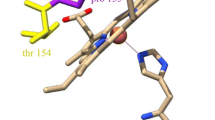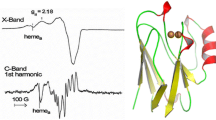Abstract
Bacterial nitric oxide reductase (cNOR) is an important binuclear iron enzyme responsible for the reduction of nitric oxide to nitrous oxide in the catalytic cycle of bacterial respiration. The reaction mechanism of cNOR as well as the key reactive intermediates of the reaction are still under debate. Here, we report a computational study based on ONIOM (DFT:MM) calculations aimed at investigating the reaction mechanism of cNOR. The results suggest that the reaction proceeds via the mono-nitrosyl mechanism which starts off by the binding of an NO molecule to the heme b3 center, N-N hyponitrite bond formation as a result of the reaction with a second NO molecule was found to proceed with an exothermic energy barrier to yield a hyponitrite adduct forming an open (incomplete) ring conformation with the non-heme FeB center (O-N-N-O-FeB). N-O bond cleavage to yield N2O was shown to be the rate-limiting step with an activation barrier of 22.6 kcal mol-1. The dinitrosyl (trans) mechanism, previously proposed by several studies, was also examined and found unfavorable due to high activation barriers of the resulting intermediates.

Bacterial nitric oxide reductaseᅟ















Similar content being viewed by others
References
Wasser IM, de Vries S, Meönne-Loccoz P, Schröder I, Karlin KD (2002) Chem Rev 102:1201
Hino T, Matsumoto Y, Nagano S, Sugimoto H, Fuku-mori Y, Murata T, Iwata S, Shiro Y (2010) Science 330:1666
Moenne-Loccoz P, de Vries S (1998) J Am Chem Soc 120:5147
Girsch P, de Vries S (1997) Biochim Biophys Acta 1318:202
Kumita H, Matsuura K, Hino T, Takahashi S, Hori H, Fukumori Y, Morishima I, Shiro Y (2004) J Biol Chem 279:55247
Ye RW, Averill BA, Tiedje JM (1994) Appl Environ Microbiol 60:1053
Butler CS, Seward HE, Greenwood C, Thomson AJ (1997) Biochemistry 36:16259
Moënne-Loccoz P (2007) Nat Prod Rep 24:610
Collman JP, Dey A, Yang Y, Decréau RA, Ohta T, Solomon EI (2008) J Am Chem Soc 130:16498
Yeung N, Lin YW, Gao YG, Zhao X, Russell BS, Lei L, Miner KD, Robinson H, Lu Y (2009) Nature 462:1079
Blomberg LM, Blomberg MR, Siegbahn PE (2006) Biochim Biophys Acta 1757:240
Blomberg MRA, Siegbahn PEM (2012) Biochemistry 51:5173
Shoji M, Hanaoka K, Kondo D, Sato A, Umeda H, Kamiya K, Shiraishi K (2014) Mol Phys 112:393
Berendsen HJC, van der Spoel D, van Drunen R (1995) GROMACS: a message-passing parallel molecular dynamics implementation. Comp Phys Commun 91:43
Lindahl E, Hess B, van der Spoel D (2001) Gromacs 3.0: a package for molecular simulation and trajectory analysis. J Mol Model 7:306
Rostkowski M, Olsson MHM, Søndergaard CR, Jensen JH (2011) BMC Struct Biol 11:6
Cornell WD, Cieplak P, Bayly CI, Gould IR, Merz KM Jr, Ferguson DM, Spellmeyer DC, Fox T, Caldwell JW, Kollman PA (1995) J Am Chem Soc 117:5179
Frisch MJ, Trucks GW, Schlegel HB, Scuseria GE, Robb MA, Cheeseman JR, Scalmani G, Barone V, Mennucci B, Petersson GA, Nakatsuji H, Caricato M, Li X, Hratchian HP, Izmaylov AF, Bloino J, Zheng G, Sonnenberg JL, Hada M, Ehara M, Toyota K, Fukuda R, Hasegawa J, Ishida M, Nakajima T, Honda Y, Kitao O, Nakai H, Vreven T, Montgomery JA Jr, Peralta JE, Ogliaro F, Bearpark M, Heyd JJ, Brothers E, Kudin KN, Staroverov VN, Kobayashi R, Normand J, Raghavachari K, Rendell A, Burant JC, Iyengar SS, Tomasi J, Cossi M, Rega N, Millam JM, Klene M, Knox JE, Cross JB, Bakken V, Adamo C, Jaramillo J, Gomperts R, Stratmann RE, Yazyev O, Austin AJ, Cammi R, Pomelli C, Ochterski JW, Martin RL, Morokuma K, Zakrzewski VG, Voth GA, Salvador P, Dannenberg JJ, Dapprich S, Daniels AD, Farkas Ö, Foresman JB, Ortiz JV, Cioslowski J, Fox DJ (2009) Gaussian 09, Revision C.01. Gaussian, Inc, Wallingford
Tao P, Schlegel HB (2010) A toolkit to assist ONIOM calculations. J Comput Chem 31:2363
Zhao Y, Truhlar DG (2006) J Chem Phys 125:194101
Cramer CJ, Gour JR, Kinal A, Wtoch M, Piecuch P, Shahi ARM, Gagliardi L (2008) J Phys Chem A 112:3754–3767
Zheng J, Zhao Y, Truhlar DG (2007) J Chem Theory Comput 3:569–582
Torker S, Merki D, Chen P (2008) J Am Chem Soc 130:4808–4814
Zhao Y, Truhlar DG (2008) Theor Chem Accounts 120:215–241
Zhao Y, Truhlar DG (2008) Acc Chem Res 41:157–167
Korth M, Grimme S (2009) J Chem Theory Comput 5:993–1003
Zhao Y, Truhlar DG (2009) J Chem Theory Comput 5:324–333
Attia AA, Lupan A, Silaghi-Dumitrescu R (2013) RSC Adv 3:26194
Dolg M, Wedig U, Stoll H, Preuss H (1987) J Chem Phys 86:866
Cossi M, Rega N, Scalmani G, Barone V (2003) J Comput Chem 24:669
Blomberg LM, Blomberg MRA, Siegbahn PEM (2004) J Biol Inorg Chem 9:923–935
Blomberg LM, Blomberg MRA, Siegbahn PEM, van der Donk WA, Tsai A-L (2003) J Phys Chem B 107:3297–3308
Pettersen EG, Goddard TD, Huang CC, Couch GS, Greenblatt DM, Meng EC, Ferrin TE (2004) UCSF chimera—a visualization system for exploratory research and analysis. J Comput Chem 25:1605
Acknowledgments
Funding from the Romanian Ministry of Education and Research (Grant PN-II-ID-PCE-2012-4-0488) is gratefully acknowledged.
Author information
Authors and Affiliations
Corresponding author
Electronic supplementary material
Below is the link to the electronic supplementary material.
ESM 1
(DOCX 39 kb)
Rights and permissions
About this article
Cite this article
Attia, A.A.A., Silaghi-Dumitrescu, R. Bacterial nitric oxide reductase: a mechanism revisited by an ONIOM (DFT:MM) study. J Mol Model 21, 130 (2015). https://doi.org/10.1007/s00894-015-2679-0
Received:
Accepted:
Published:
DOI: https://doi.org/10.1007/s00894-015-2679-0




